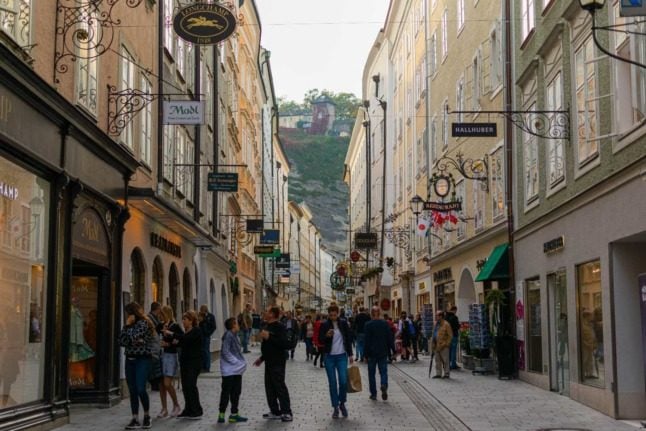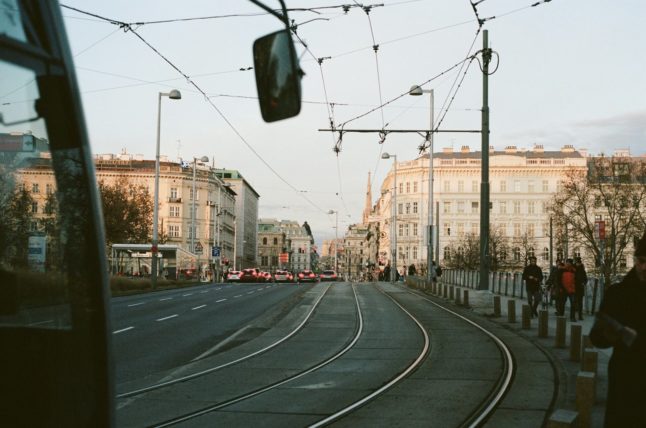The city of Salzburg is experiencing a housing crisis, fuelled by property investors, limited building space and increasingly tourism-focused infrastructure.
“In the last five years, prices have risen enormously. Much more than income levels,” says Inge Strassl, project leader for housing research at the Salzburg Institute for Housing and Regional Planning (SIR).
In the city of Salzburg, locals and newcomers alike are running up against sky-high prices and limited options when it comes to finding an apartment or home. The city’s housing crisis is the result of a slew of factors driving up demand, even when it seems there is no shortage of living space in the city and surrounding region.
“It’s not a question of whether we have enough apartments—but they aren’t always in the right place,” Strassl told The Local. “The main problem is that it’s becoming too expensive for the average person.”
Since at least 2005, the state of Salzburg has topped the charts for rent prices compared to other Austrian states, according to SIR’s latest report. In that time, Austria has seen an average rent increase of 57 percent, bringing a typical Salzburger’s rent from 6.50 euros per square meter up to 9.90 euros by 2020.
Renting in Austria: The vocab you need to understand apartment ads
For those looking to buy, the leap in property value was even more stark. From 2009 to 2019, the sales price for new homes inside the city jumped by 70 percent, while the price tag on existing homes nearly doubled.
Today, a 150 square meter apartment or house on the city outskirts can sell for one million euros or more.
New tenants face elevated costs
Compared to the rest of the world, Austria’s rent-to-income ratio is fairly middling—about 20 percent of the average Austrian’s income went to rent in 2019, according to a recent OECD study.
That’s higher than Germany and the EU as a whole, but lower than France, Italy, Switzerland and the United States.
What the numbers don’t show though, is which groups have access to more affordable housing, and how much more money new tenants are paying compared to the old. On this issue, Salzburg is the perfect case study.
Bernhard Gugg, a housing researcher with SIR, told The Local that new tenants can expect shorter rent contracts and more frequent price hikes than in previous years.
READ MORE: Is it better to buy or to rent property in Austria?
“Around two-thirds of new rent contracts are set for three years,” Gugg says. “After it expires, landlords can actually raise the price again.”
According to Gugg, the current rent price on the market is around 17 euros per square meter, including upkeep. In Austria, it’s typical for a landlord to charge three month’s rent as a security fee, while real estate brokers often charge another two month’s rent for their services.
That means the upfront fee to move into a two-room apartment in Salzburg could total up to 5,400 euros for the first month.
Inaccessible subsidised housing
Gugg also says that newcomers, especially non-Austrians, have trouble accessing Salzburg’s more affordable subsidised housing, which makes up approximately one quarter of the city’s housing stock.
“That’s not available for internationals, or for people who move here for studies or work,” Gugg says. Only five-year residents of the city are eligible to apply.
But even locals face a long waiting list. According to Strassl, low turnover in the city’s subsidised housing stock is further exacerbating Salzburg’s housing crisis.
EXPLAINED: Five common apartment scams in Austria
“The problem is that people don’t move out of these apartments again,” Strassl says. “They stay, and want to live there forever. So there is no exchange.”
As a result, groups that normally rely on lower-priced housing for their first apartment or home have to look elsewhere—and that often means settling for cramped or lower-quality housing on the private market.
“It’s the younger population and the young families,” Strassl says, that are feeling the brunt of the impact—especially immigrants. She has come across many immigrant families with several children, often having to live in small, two-room apartments.
“The private rent is so high that it’s not possible to save a lot of money,” she says. “It’s creating a split—the gap is widening,” she says, between renters and owners.

Empty buildings and restricted space drive up demand
Salzburg’s housing availability is also being diminished by a recent boom in the purchase of property for investment—houses and apartment buildings that investors often leave empty because they generate income all by themselves, without the need for tenants.
The city’s real estate sites are full of advertisements geared toward investors, complete with annual profit estimates. One listing on the housing board run by Salzburger Nachrichten is titled: “Apartment package: 4 top-rented investment apartments with a yield of 2.9%.”
In order to capitalise on the profits, Gugg says, private building companies are snapping up land in a city with restricted space.
“What’s quite difficult in Salzburg is that you really don’t get a lot of new land for any kind of development—not just housing,” he says. That steep competition makes it hard for affordable-housing associations to recoup their costs and keep prices low for residents.
According to Strassl, many properties in the city, old and new, are bought up by small investors looking for a place to park their money instead of the bank.
“In the city of Salzburg, you can be sure that [a property] will not lose it’s worth,” Strassl says. “Of the people who buy them, not all rent them again, so there are a lot of apartments now that are sold and not used.”
A 2015 SIR study found that about 3,500 viable living spaces in the city remain vacant year-round, inaccessible to the public. While that’s only about 4 percent of the available supply, it’s indicative of a growing market, that—combined with Salzburg’s restricted building space—is pushing some residents out.
Renting in Austria: When can my landlord increase the rent, and by how much?
A blessing and a curse
There’s one final factor putting pressure on Salzburg’s housing market, wrapped up with all the rest: Salzburg’s allure for tourists, vacationers and second-home buyers.
The city’s “attractiveness is not only a blessing for Salzburg, but also a curse,” reports a 2019 study out of the Salzburg University Geography Department.
Salzburg’s charming surroundings, comfortable amenities and cultural tourism draw millions of visitors over the course of a normal year. In 2019, Salzburg hosted three million overnight stays—approximately 8,200 additional residents each day of the year in a city of 155,000.
According to the study, tourism in Salzburg has captured a large swath of housing, including vacation homes and short-term rentals posted through portals like Airbnb, which often remain partially empty during the year. At least 17 percent of living spaces in the city are secondary residences, while the number of short-term rentals is hard to quantify.
What’s clear is that Salzburg’s city centre is remarkably vacant of local residents. The resident population there fell 15 percent in the ten years leading up to 2019, says the study, as the city’s changing infrastructure increasingly accommodates tourists.
Strassl says the price jumps and high demand haven’t stopped there. “It’s extreme in the city, but it’s also coming around in the surrounding area. In the whole region of Salzburg, you will not find a really cheap place.”




 Please whitelist us to continue reading.
Please whitelist us to continue reading.
Member comments